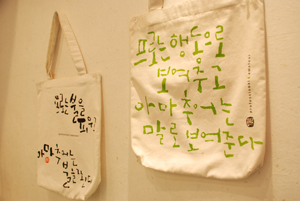Prospects for hangeul design goods

HAVE YOU ever seen foreigners wearing t-shirts with large, plain Korean letters on them, often provoking bemusement? The picture of Britney Spears wearing a worldwide brand Dolce & Gabbana dress with strange Korean alphabet on is an example. The hangeul products made in the past were often cheaply printed with no artistic design put into them. In contrast, the hangeul items made recently have taken design into consideration. Now, hangeul design is used not only in fashion, but also in art works, public design, etc. The paradigm concerning hangeul has started to shift from a mere language to a field of design.
Merits of hangeul as a language
The excellence of hangeul as a writing system is renowned among international linguists. According to the best linguistics research center in the world, Centre for Linguistics and Philology, University of Oxford, hangeul ranked the first among writing systems of the world in terms of rationality, originality, functionality, etc. It was the Great King Sejong who created such incredible Korean script, hunminjeongeum, which refers to the Korean alphabet, in 1443. Because hangeul was designed to help the uneducated commoners read and write, the principles on which the shapes, meanings, and combinations were made are systematic and scientific, making it easy to learn. Due to these features of hangeul, Korea’s illiteracy rate is one of the lowest in the world. In this context, even UNESCO rewards individuals or organizations that achieve effective results in fighting for literacy with the King Sejong Literacy Prize. The prize honors the outstanding contribution King Sejong made to literacy by creating the one and only commissioned writing system, hangeul. Moreover, hangeul was designated as a global documentary heritage by UNESCO’s Memory of the World Programme in October, 1997. While hangeul is recognized as one of the most outstanding writing systems in the world, such acknowledgement is not as great within Korea.
|
|
|
|
|
| ||
|
| Bags with hangeul design | |
Potential of hangeul as design
Although many Koreans perceive hangeul as no more than a language medium, its latent possibilities for design have begun to be noticed. The geometrical shapes of hangeul possess modern formative beauty. Such shapes include horizontal, vertical, and diagonal lines, circles, and squares. “With the 24 Korean consonants and vowels, 2,350 complete letters can be formed; however, the possible combination of the consonants and vowels put together by the system of hangeul, even if they do not make sense, are up to 11,172 letters. “This means that hangeul is an abundant source of design,” says Shin Seung-il (Director, Hallyu Research Institute). In fact, if the letters are altered in size, angle, thickness, color or distance between related letters, infinite design patterns can be drawn out. One of France’s top fashion designers, Irene Van Ryb, says, “Hangeul will open up a new horizon in the worldwide field of design.”
The recent hangeul design products can be defined as hangeul cultural products. These products include items with hangeul design patterns on them or molded into the shapes of hangeul, designed to possess greater attractiveness. The hangeul cultural industry can be divided into three branches: the fields of cultural products; arts; and design. The cultural products field consists of clothes and daily commodities, whi. The arts sphere involves sculptures, performances and paintings. The design branch encompasses public design and handwritten calligraphy.
|
|
|
|
|
| ||
|
| A door with hangeul design applied | |
Appearance of hangeul design products
Items using hangeul have long existed, but the production of goods with hangeul as a design feature only became common among small enterprises as recently as 2005. Larger corporations began to make hangeul design products only from 2007, and many goods have been introduced this year. “It is not important when this industry started; that hangeul design products have caught attention recently is the point,” says Yoon Sang-feel (Senior manager, Philmuk, design and calligraphy enterprise). Indeed, the interest in hangeul design goods took off when the Korean fashion designer Lie Sang-bong introduced apparels with hangeul designs on them in 2006 at Pret-a-Porter Paris, one of the top ready-to-wear collection fashion show worldwide. This inspired the designers, gave the public a fresh impact, and even led to an exhibition displaying hangeul fabric attire made by foreign fashion designers. Another pioneer, Lee Geon-maan (CEO, LEE-GEON MAAN AnF Co., Ltd.), recalls, “Korean culture and its expression in arts has always been my interest. I contemplated what originated naturally from Korea, and came to conclude it was hangeul. It flashed through my mind to apply hangeul on fashion commodities and make them seep into people’s daily lives.” If the goods of the people mentioned above are rather high-quality and expensive, there are also companies dealing with products accessible to the broader public. An online general shopping mall specializing in hangeul design products called Tium Mall (www.tiummall.com) opened in May, 2008.
Some organizations hold occasional events related to hangeul. A Korean casual clothing brand Basic House introduced t-shirts with pictograms of Olympic sports using hangeul, and held an event related to the 2008 Beijing Olympic Games. Last year, Hangeul Munhwa Yondae, a citizens’ group promoting hangeul, held an event around Oct. 9, Hangeul Day, where they opened a fashion show and gave out hangeul design t-shirts for free. Such diverse efforts to popularize hangeul design goods demonstrate the bright prospect of the hangeul design industry.
|
|
|
|
|
| ||
|
| Fashion commodities of Lee Geon-maan | |
 | ||
| Hangeul apparel at a fashion show | ||
Difficulties in commercializing hangeul goods
Because the concept of a hangeul design industry is still in its formative stage, it has many difficulties to overcome in commercializing. First of all, there still exists a bias of some against hangeul design goods as not worthy of buying. Likewise, the fundamental problem lies in the way of thinking. “Koreans do not have pride in what is ours. Even in the far past, the educated noblemen used Chinese characters to write, and hangeul was used by women, who were considered as inferior at that time,” says Lie. “Our way of considering what is peculiar to us as belonging to the lowest stratum of society should be changed. We should learn to embrace what is native to us and realize its worth,” Lie adds.
Secondly, there is concern that everyday items and clothes do not have much added value. “Not much profit was gained from hangeul products like t-shirts and masks from my company. We expect to gain profit from hangeul furniture due to the costliness of the object itself,” says Kim Jung-ran (Graphic Designer, 601BISANG, graphic design company). “The field of arts using hangeul has a lot of added value, so more focus on this branch is imperative,” comments Lee Sang-gyu (Director General, The National Institute of the Korean Language). Further development is required in items that have high added value like electronics, furniture, or art works.
Finally, since the hangeul design industry is non-mainstream, it is hard to get support from the government. Most of the corporations creating hangeul design goods are doing so rather purposely for the promotion of the country, as well as to make profits. Kim says, “The ultimate aim of my company is to change the souvenirs at the Blue House into our products, and to build the image of Korea by doing so, making profits on the way.” Regardless of such factors, the only existing aid from the government is the Hangeul Pattern Clothing Developing & Popularizing Project, held by Hangeul Munhwa Yondae. Last year, covering the pavement of Sejong-ro with hangeul designed blocks was chosen as one of the Seoul government’s policies by Internet voters. Hopefully, the increased consciousness that Internet users have about hangeul will raise the government’s interest toward it.
To become a national brand
According to The Anholt-Gfk Roper Nation Brands Index, which measures the power and quality of each country’s brand image, Korea ranked 32nd in 2007. This rank has declined from 25th in 2005 and 27th in 2006. A nation’s image and reputation influence the success of the country greatly in terms of economic, political and cultural relations with other nations. Developing the hangeul design industry would be an effective national strategy to increase the competence of the country.
Primarily, the earlier-mentioned prejudice of ordinary people against hangeul items should be mitigated. For hangeul design items to go abroad and succeed, holding a firm, steady stance in the domestic market would be a prerequisite. “Koreans have always considered it shameful to show off, and have been stingy about praise, but such customs should be changed. With dignity about Korean indigenous culture, Koreans should boldly express their culture, including hangeul, on the world stage,” says Lie, as a way to alter Koreans’ thoughts on hangeul goods. Hangeul should be reinterpreted from a designer’s perspective and we should contemplate how to make goods appealing, even if hangeul is on them. This way, consumers who first perceive the designs as mere geometrical shapes would soon realize they are actually hangeul,” says Kim.
For hangeul to develop into a national brand, the government should encourage creative inventions by assisting commercialization of the hangeul design industry and provide necessary support as a long-term strategic scheme. So far, the government’s attention to the hangeul design industry is more or less insufficient. As a good example to follow, after Oh Se-hoon became the Mayor of Seoul, more emphasis has been put on public design, and hangeul design has been considered as a potential option. Nonetheless, more efforts should be put in by both companies and the government. “As an individual company, it is hard to get subsidies from the government; thus, organizations should revise cultural projects so that the government can back them. My company makes t-shirts with ‘I will protect Dokdo’ printed on them, which we sell at prime cost. However, we could give these out for free if the government supported us,” says Yoon.
Lastly, cooperation among the people, government and industry is required in order to share ideas and influence each other effectively. “Designers and those related to humanities such as scholars of Korean literature, psychology, or philosophy should cooperate to increase the value of hangeul design goods,” says Lee Sang-gyu. In fact, collaboration among artists and enterprises is already happening, such as the gathering of artists and corporations that use hangeul as a source of design and art called Hangeul Sarang Undong Headquarters. Following this precedent, greater interaction among academia, artists, the cultural sector, and companies should be developed as well.
* * *
Every nation has its own unique images as perceived by foreigners. For instance, Japan is well-known for sushi, kimono, and sumo wrestling, while Korea is less known in terms of cultural items despite kimchi, taekwondo, and the Korean wave. The reason, according to Lee Geon-maan, is, “While Japan attracted the foreign countries with their authentic culture first, and then approached them as a civilization, Korea did the opposite. This can be a lag in the long run.” To spread the image of Korea as a culturally abundant nation, its image must be revised. Hangeul, the most Korean of all cultural heritages, is a leading nominee to represent the nation. The quality of hangeul design products has improved greatly, and their future is even brighter. To step forward, the hangeul design industry cannot merely rely on Koreans’ patriotism; the industry will flourish only when the goods are extraordinarily outstanding themselves. Yet, for a seed to sprout, watering is vital. Our attention can be a driving force for the hangeul design goods to bloom. Let us give hangeul a chance, and take a good look at what it has to offer.




